With an indirect method, the learner receives explanations using an intermediate language (such as his or her native language) so that he or she can understand.
With a direct method, the learner receives explanations in Japanese only.
If your native language is English, you may worry about whether it’s better to temporarily get explanations in English or to get explanations in Japanese. In this article, I will explain the pros and cons of both methods.
Indirect Method – Pros
-Explanations are definitely easier to understand.
-Learners can understand in a short amount of time.
Indirect Method – Cons
– It’s easy for learners to develop a habit of always thinking in their native language.
-It’s hard for learners to develop a habit of reasoning based on the Japanese they know.
-There may be many instances of not understanding when having an actual conversation in Japanese.
Direct Method – Pros
-Learners will develop a habit of reasoning based on words they do know even if there are words they do not understand.
-Lessons can be taken in a form that closely resembles an actual conversation in Japanese.
Direct Method – Cons
– Learners will sometimes misunderstand.
-It may take a while before the learner can understand.
The indirect method is less stressful because beginners cannot understand explanations in Japanese. However, the advantage of studying using the direct method from the beginning is that learners are better prepared for a real conversation because they have been listening to actual conversations in Japanese only. In other words, the difference is whether you consider speaking only in Japanese as “stressful” or “good training.”
I recommend the following approach for people who want to become used to Japanese as quickly as possible, but who also want to use their lesson time efficiently.
・First, tell your instructor ahead of time not to use an intermediate language unless you request otherwise, and basically use Japanese only.
・Then, ask your instructor for explanations in an intermediate language only when you can’t understand no matter how hard you try.
However, make an agreement with your instructor not to use an intermediate language more than three times per lesson.
(It doesn’t matter if you agree to five times or ten times, it’s just seems best to use an intermediate language as little as possible.)
・Then, do not use an intermediate language more than the agreed number of times no matter how frustrating it becomes.
I recommend this approach because, by sticking to these rules, you will develop a habit of thinking for yourself as much as possible even when you don’t understand and you can enjoy your lessons like a game.
8 points to make your trip to Japan more fun
May 16, 2020
It’s difficult to travel right now, but when the coronavirus is over, I hope that many people will enjoy their trip to Japan. In this article, we’ll introduce eight points to help you plan your trip to Japan and make it even more fun.
First of all, there are five points to make a plan for your trip to Japan.
- Decide on a theme for your trip.
- decide on a budget and number of days
- Decide where you want to go.
- make a list of things you want to do
- try to make a real schedule
Let’s take a closer look. The order of 1 to 4 may be back and forth. You may have to rework your plan a few times, but it’s still a process of making a better plan, so enjoy it.
- Decide on a theme for your trip.
If you’re new to Japan or have never traveled to Japan before, you can use “Tokyo and Osaka” as a theme for the cities you want to visit. If you are a repeater, for example, you may want to have a specific theme such as “I want to compare delicious sushi,” “I want to go to many hot springs,” or “I want to take a good looking photo for Instagram. Once you’ve listed a few, think about those priorities.
- decide on a budget and number of days
Deciding on a budget and number of days is a necessary step to make it a realistic plan.
- Decide where you want to go.
It’s normal to want to go to as many places as possible. Decide where you can realistically go with your purpose, budget and days.
- make a list of things you want to do
Decide specifically where and what you want to do and make a list. If there are too many to list, consider those priorities as well.
- try to make a real schedule
Find out where to stay, how to get there, how long it will take, and how long it will take to do the things you want to do. In Japan, trains and planes often go as planned, but make sure you have plenty of time on your schedule.
These are the basic points.
Next, I’ll give you three tips to make your trip to Japan more enjoyable.
6.Look up not only on the web but also in guidebooks.
Research can be done on the web, but it can be time consuming to look up each site one by one. So I buy a guidebook that allows me to look up information efficiently. Looking through guidebooks with my family and thinking, “Oh, I want to go to this store too! The price is also cheap at around 1,000 yen per book.
FYI, “Rurubu” and “Mappuru” are the most famous guidebooks in Japan. Both are designed for Japanese people traveling in Japan, so there is only a Japanese version, but it has detailed information on it. There are a lot of photos, so even those who are not confident in their Japanese will find it helpful.
Rurubu Tokyo https://amzn.to/2WlcdDU
Rurubu Osaka https://amzn.to/35SP8vt
Rurubu Hokkaido https://amzn.to/3bjnvwE
Rurubu Okinawa https://amzn.to/3cvfYwk
7.Ask a travel planning professional.
If you’re not good at planning or don’t have the time for it, you might want to hire a travel planning professional. COCONALA is a site that deals with the skill sharing economy business and there are also people who can help you plan your trip.
https://coconala.com/services/45520?waad=twyeQ5fH
This person will make a plan for 2 nights and 3 days for 1,500 yen anywhere in Japan.
https://coconala.com/services/45883?waad=twyeQ5fH
This person will plan a trip to Hokkaido for 3 nights and 4 days for 3,000 yen.
8.Make an album after the trip.
When we travel abroad, we make an album for each trip. Photo data taken with a digital camera or mobile phone is a rare opportunity for the whole family to look back at it. It’s a great way to keep an album to enjoy your family’s time together and memories of your trip.
If you are a Japanese language learner, try to look up information in Japanese as much as possible.Talking to your Japanese teacher about your travel plans will be a good practice for you too!
Writing practice is hard, but it’s effective.
April 15, 2020
Do you write Japanese?
There are many people who say, “I have a chance to speak Japanese, but I don’t have a chance to write. There are also many people who say, “I’m practicing speaking Japanese but not writing.
So, today I would like to tell you about the benefits of writing practice. You will be able to write for the first time if you have what you want to say organized in your mind and know the vocabulary and expressions. This means, conversely, that if you can write, you can say.
However, there is one point to note. hat is to write the amount and theme sentences that fits your level. It’s hard for a beginner to write long sentences on a complex topic. The target number of characters for each level is shown in the following table, so please refer to it.
———————————-
Level Number(Time)
———————————-
10 700 letters(3 mins)
9 600 letters(2 mins)
8 500 letters(2 mins)
7 400 letters(2 mins)
6 350 letters(1 mins)
5 300 letters(1 mins)
4 250 letters(1 mins)
3 200 letters(1 mins)
2 150 letters(1 mins)
1 100 letters(30sec)
———————————-
*Level is based on J-OS’s ten-level.
*Time is the target speed to read the sentences you wrote and it almost same as the speed of the Japanese announcer.
It’s hard to practice writing, but that’s why it works. Please give it a try.
In Japan, there are many adults who read manga, but it seems that in some countries it is embarrassing for adults to read manga. Most J-OS users are business people, so there may not be many people who read manga, but there are many Japanese manga that even adults can enjoy. Therefore, this time we have collected business-themed manga so that business people can enjoy it.
Kacho(Manager) Kosaku Shima https://amzn.to/2uGyG35
Speaking of manga whose leading role is a business person, many Japanese will probably mention this. It has also been turned into a TV drama. The main character is Kosaku Shima, who works for a major electronics manufacturer in Japan, and there are many current events and situations that are likely to happen, such as mergers of competitors and measures to take over from overseas companies. Kosaku Shima, who was the manager at the start of the manga, became a division chief, a director, and was promoted to the president. When his title changes, the title of the work will also change, such as “Division chief Kosaku Shima” ” Director Kosaku Shima” and “President Kosaku Shima”
A bilingual version of “K Division chief Kosaku Shima ” https://amzn.to/2ONPN9Y9 ?” President Kosaku Shima ” https://amzn.to/31OfZXrX ?is also available.
Salaryman Kintaro https://amzn.to/2w3S22v
This Manga is also popular and has been turned into a TV drama. Kintaro Yajima, the main character, is a salaryman working for a construction company, and his work and growth are drawn. There is also a series that has changed jobs to a foreign investment bank.
Investor Z https://amzn.to/2Hkekj8
A manga that allows you to deepen your understanding of investment and has a reputation for nurturing your mind as an investor while enjoying the story.
Kaisha Shikiho, a company that provides corporate information, describes this as “a manga that gives both beginners and experienced investors a” notice “to win.” Also, many real Japanese entrepreneurs have appeared, and there are many collaboration projects with real companies.
Concierge https://amzn.to/2SznE7S
A story that uses the hotel’s concierge as the main character and solves various problems and requests that guests and staff cause. Not only people working in hotels, but everyone who serves customers will enjoy it.
Yamikin(Illegal high interest lenders) Ushijima-kun https://amzn.to/2vo5NJg
This work has been turned into a drama and a movie.
Although the main character is an illegal high-interest lender, the content is dark, but it is a work that reminds you not to get involved in money troubles, and many entrepreneurs recommend this. Recommended for those who want to know about Japan’s dark society.
There seems to be a lot of Kindle versions recently, so please try it. And if you like, please see this article I wrote earlier.
Japanese business magazine TOP 10 recommended for business Japanese learners!
https://j-os.com/en/japanese-business-magazine-top-10-recommended-for-business-japanese-learners/
Popular 18 Business Japanese Dramas recommended for business Japanese learners!
https://j-os.com/en/popular-18-business-japanese-dramas-recommended-for-business-japanese-learners/
Job popularity ranking is not useful
December 18, 2019

If you work in Japan, what are the criteria for choosing a company?
When you find a job in Japan, you will see the “Job popularity ranking, but frankly, this ranking is not useful, so in this article, I will explain why and will introduce some other rankings.
Reason 1: The respondents are college students who has just started job hunting.
Companies that make such rankings often take questionnaires to university students who come to joint company briefings. For this reason, the number of companies that respondents know and the actual situation of the companies are extremely limited. It’s like asking a zero-beginner Japanese learner about recommended business Japanese materials.
Reason 2: The reality is just name recognition ranking
This is related to the first reason, most of the top ranking companies are doing BtoC business rather than BtoB. There are many excellent BtoB companies in Japan, but such companies are not well known, so they do not appear in the ranking.
So what ranking should you refer to instead?
Here are some suggestions.
Suggestion1:Job change popularity ranking
Example : https://doda.jp/guide/popular/
The respondents are already working, and the question is “Which company is better if you change jobs?”, That will be closer to the actual evaluation of the company than to ask students.
Suggestion2:Average annual income ranking
Example : https://toyokeizai.net/articles/-/257530
Many people think salary is the most important. For those people, the average annual income ranking of employees will be helpful.
Suggestion3:Lifetime wage ranking
Example : https://toyokeizai.net/articles/-/310498
In Japan, where the lifetime employment system was strong, there are many people who place importance on the ranking of lifetime wages rather than annual income.
Suggestion4:Ranking of employees working overseas
Example : https://toyokeizai.net/articles/-/206216
There are many people who are worried about whether they can return to their home country in the future, work at a place where they can use their language skills, or do business globally. This is a ranking that allows you to know how many people work for the company overseas.
The operating profit margin ranking and overseas sales ratio ranking may also be helpful for you.
However, such ranking varies depending on the industry and business model, and may vary depending on the time of aggregation. For this reason, it is better to think that there is no ranking that perfectly meets your requirements.
So what should we do?

If you have a specific industry or job type that you want to work with, it may be good to create your own ranking based on that industry or job type. Also, if you are concerned about both the average annual income ranking and ranking of employees working overseas, it may? be good to create a list of companies that are ranked in both.
In this article, I wrote about how to use rankings, but it is always recommended to consult with people who are already working in the industry you want to go to without using such rankings.
Our free video course called “Japanese for Job Hunting” is available on YouTube.
I would be happy if you could register for your channel or do a GOOD evaluation 🙂
https://www.youtube.com/channel/UCZtUc_wd7BOKT9BvhRjyvsg/featured
I hope you all succeed in getting a job or changing jobs.
Listening to audiobooks can be a good way to practice listening skills for business persons
November 16, 2019
Do you know about “Audio Book” and “Audible”? “Audible” is the name of audio books operated by Amazon. The audio books are “listening books” read by narrators and voice actors, and you can enjoy reading while traveling in a train/car, doing housework, and out for a run.
About a year ago, one of my friends told me about Audible, but I questioned the value of the service at that time because there were few business books.
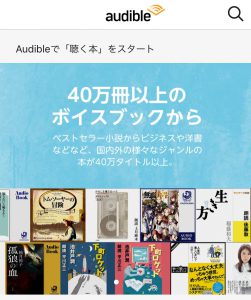
But recently one of Japanese teachers in our school introduced me Audible again.
This time I tried it because I found a book that I just wanted. Now I am into Audible service and not skeptical about the audio books service anymore.
So, in this edition, I summarized the benefits of Audible.
Advantage 1: Adjustable playback speed
You can adjust the narration speed of your Audible audiobooks from 0.5x to 3.5x.
You can listen the narration slowly at first, then increase the speed when you get used to it. In this way, it will be perfect to practice listening Japanese.
Advantage 2: You can choose business books as listening theme
If you choose a business book, you can get useful business information at the same time as you practice listening, so it is like throwing one stone to kill two birds.
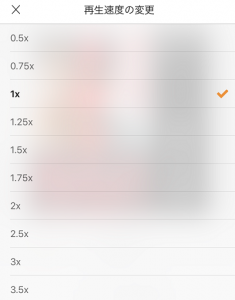
Advantage 3: You can read the book review
Pod Cast is similar to Audible, but the quality of its content varies depending on the distributor.
On the other hand, Audible shows reviews from people reading the same book, so you can tell in advance whether you want to read the book.
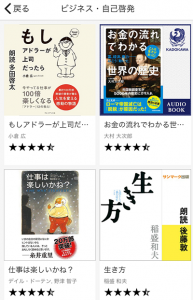
Advantage 4: Possible to save reading time
It is difficult to read books while walking, but you can listen Audible while you are moving from the station to the office, walking, or driving.
I often read books when moving to other place, so it usually takes a few days to read a business book.
But this time, I was able to finish reading (listening) one book in a day through Audible. By the way, I listened at double speed.
Of course, there are also disadvantages, whic is a monthly fee.
In the past, if you pay a monthly fee, you can listen books unlimited, but now you can listen only one book for monthly fee. If you want to listen the second one, you have to buy the book at a discounted price.
For example, the book I read this time called “Multi-Power” is 1,540 yen for a normal book, but 418 yen for a Kindle.
The monthly fee for Audible is 1,500 yen, so the Kindle is cheaper.
However, this is unavoidable because recording and producing audio book properly need a long process.
(All figures are as of November 07, 2019)

For busy business persons, time is money, so I think Audible is worthy even with high prices.
Now, you can pick your first free book to give this service a try.
https://www.amazon.co.jp/b/ref=adbl_JP_as_0068?ie=UTF8&node=5816607051&tag=japanonlinesc-22
After your Audible 30-days trial expires, it costs 1,500 yen per month, but you can cancel the service before the expiration.
Listening practice is more fun when you listen the theme what you are interested in. I hope this will help your Japanese learning.
“What are the recommended textbooks?”
This is the most difficult question I ever be asked to answer.

The criteria for choosing textbooks varies depending on Japanese learning history, learning goals, learning style, learning environment, budget, and preferences.
So, what factors should be considered in choosing textbooks?? In this edition, we summarized tips for choosing textbooks.
(1) Do not trust Amazon Reviews
I often shop on Amazon and always check for customer reviews before buying a product.
However, customer reviews on Amazon are not trustworthy when choosing textbooks, because there are few reviews considering the factors mentioned above. As for different learners, it has to be taken into account each learning environment, budgets, and so on, but no customer reviews consider them.
Also, there are regional differences in the evaluation of customer satisfaction.
For example, the customer evaluation for the “Japanese for Busy People I: Kana Version (Revised 3rd Edition)” that we often use in lessons for beginners are as below.
(Information as of 10/11/2019)
————————————————-
Country /Stars out of 5/Number of reviews
————————————————-
Japan / 3.5 / 14
US / 4.1 / 85
UK / 4.4 / 100
CA / 4.3 / 19
————————————————
Even with the same product, you can see the 0.9 points difference between Japan and UK.

(2) There are only a few textbooks stocked in general bookstores.
When I go abroad, I go to a large bookstore in the area and check what kind of textbooks are sold. Since there are only a small number of Japanese learners overseas, Japanese textbooks do not contribute much to the sales of bookstores. Therefore, there are only a few textbooks are stocked.
(3) Don’t trust an advice of any bookstore clerks
A general bookstore clerks will never know about learning Japanese so that you can not expect the advice of the store clerk. They might tell you the most popular textbooks, however, the best-selling textbooks are not necessarily the best textbooks for you.
(4) Don’t trust the advice of ordinary Japanese people as well
If you have Japanese friends, you may ask them for advice. However, ordinary Japanese do not know about Japanese language education for foreigners at all. They don’t even know what textbooks are available for learning Japanese.

For the above reasons, choosing textbooks is not so simple. So, what will be reliable sources on choosing textbook?
Here are some sources on people and sites helpful for your decision.
(1) Professional Japanese teacher
Professional Japanese teacher will most likely give you the best answer. However, of course, there are both amateurs and professionals. To give you a good advice on recommended textbooks, teachers need to have a deep understanding of many textbooks, but some teachers have used only a few. Which advice is more reliable by teachers who have experienced only one textbook or one have used 100? Ask how many books the teacher has experienced before.? You will be able to trust an advice of a teacher who has use at least 10 books, preferably 20 books.

(2) Special shop in Japanese language teaching and studying materials
If you can buy textbooks in Japan, you can go to a special shop in Japanese language teaching and studying materials and check them.
Here are some links to special shops in Japanese language.
Bonjinsha http://www.bonjinsha.com/
Japanese Bookstore Sogakusha http://www.sogakusha.co.jp/
Japanese Books Online http://books-online.jp/

(3) Friends who are fluent in Japanese
If you have friends who have already reached your ideal Japanese level, their opinions may be helpful for you. Especially friends of the same native language of you will be reliable. However, it is important to understand that the person does not know much of the Japanese teaching material, but only gives advice to you based on his/her limited experience.
(4) Japanese language School curriculum
If any of the above is difficult to find, the textbook used at the Japanese language school may become a tips for you. Japanese language schools usually have courses by level and learning purpose, so check the textbooks close to your level and purpose. Recommended learning materials for each course are also listed on the J-OS website. If you are interested, please refer to the following page.
For English
General Japanese Course>
https://j-os.com/en/courses/generalcourse/
JLPT Preparation Course>
https://j-os.com/en/courses/jltpprepcourse/
Business Japanese Course>
https://j-os.com/en/courses/businesscourse/
For Japanese
General Japanese Course>
https://j-os.com/ja/courses/generalcourse/
JLPT Preparation Course>
https://j-os.com/ja/courses/jltpprepcourse/
Business Japanese Course>
https://j-os.com/ja/courses/businesscourse/
* The main users of J-OS are English-speaking people or English-speaking business persons. Therefore, please note that the information may not be suitable for non-English speaking people and students.
What did you think about these tips?
Whether or not you can find a good textbook is an important factor of successful Japanese learning.

In Japan, there are two major ways to do Karaoke:
(1) at a Karaoke Box:
You are assigned your own room for you and your party to enjoy. It is a good option to enjoy karaoke with your friends or fellow workers.
(2) at a Karaoke Snack Bar:
It is a small individually-owned bar that usually has a single Karaoke machine, so you need to share a karaoke machine with other guests.
About Karaoke Snack Bars, please refer to the following article for details. (Only Japanese)
https://loohcs.jp/articles/293
At a Karaoke box, your party can enjoy karaoke on your own ways, however, at the karaoke snack bar, you need to be careful to choose songs depending on the atmosphere and the other customers. In such bars, it is not so “cool” to sing only anime songs or songs popular among young generation.
In this edition, I will introduce a selection of famous Japanese songs that make you special.
There are 10 songs for each male and female singer.
All songs are very popular among 50’s to 60’s Japanese, that melody is not so quick and lyrics are simply understandable.
If you go to karaoke with senior Japanese business people and sing a few these songs, you will be no doubt to be considered “you are so SHIBUI(You have really good taste)!”
■ Songs by male singers
Natsu no owari no harmony (Yoosui Inoue / Kooji Tamaki)
This song is covered by many singers and known to people of a wide range of ages.
Https://www.youtube.com/watch?v=WCSeiSOaHxY
Mata au hi made (Kiyohiko Ozaki)
https://www.youtube.com/watch?v=5NVcDuS_hxM
Hajimari wa itsu mo ame (ASKA)
https://www.youtube.com/watch?v=74IKR0WeKXY
Nani mo ienakute …natsu (JAY WALK)
https://www.youtube.com/watch?v=ZkoQPOhhu38
Sake to namida to otoko to onna (Eigo Kawashima)
https://www.youtube.com/watch?v=tjrPAAiCbuA
HERO (Kai Band)
There are many songs with the same title. Please search on the “Kai band.”
https://www.youtube.com/watch?v=ZVU3BVmxxU8
Azusa 2 goo (Kariudo)
https://www.youtube.com/watch?v=OCK-nWaYxJE
Saigo no ame (Yasushi Nakanishi)
https://www.youtube.com/watch?v=JmmPzK0chqU
Kowarekake no Radio (Hideaki Tokunaga)
https://www.youtube.com/watch?v=C7QVaahn44A
Kanashii iro yane (Masaki Ueda)
Those who speak Kansai dialect should master this song!
https://www.youtube.com/watch?v=xQeEOoKhIqg
■ Songs by female singers
Ito (Miyuki Nakajima)
This is a very popular song at weddings.
I couldn’t find the original video, so I will introduce other singers are singing instead.
https://www.youtube.com/watch?v=DboG2xszmcE
This video that amateur singing at a wedding is also popular.
https://www.youtube.com/watch?v=aXwIawYfkjgs://www.youtube.com/watch?v=aXwIawYfkjg
Amagi goe (Sayuri Ishikawa)
https://www.youtube.com/watch?v=yvc0LadtZuk
Love is Over (Ouyang Fei Fei)
https://www.youtube.com/watch?v=zzRsmDHmZJI
Kawa no nagare no yooni (Hibari Misora)
Hibari Misora is called a “Diva of Shoowa.”
https://www.youtube.com/watch?v=d_Ns_B23LT0
Ano kane o narasu nowa anata (Akiko Wada)
https://www.youtube.com/watch?v=mdLydN0liYQ
Toki no nagare ni mi o makase (Teresa Teng)
https://www.youtube.com/watch?v=oJY2RtLADkM
Mata kimi ni koishiteru (Fuyumi Sakamoto / Billie Bang Bang)
This song was originally a male duo “Billie Bang Bang”, but it became more famous with the cover of Enka singer “Fuyumi Sakamoto.”
https://www.youtube.com/watch?v=SBTjDVLmHn8
Miserarete (Judy Ongg)
https://www.youtube.com/watch?v=OFNW0IZUdto
Koi ni ochite (Akiko Kobayashi)
https://www.youtube.com/watch?v=7lTkywZljmk
Olivia o kikinagara (Anri)
https://www.youtube.com/watch?v=TgRQP9C1M4s
Nagori yuki (Iruka)
https://www.youtube.com/watch?v=tp9qHeMjiKg
You can easily find the lyrics of any song by searching for the keywords “song title & lyric”.
It will be a good study of Japanese to find your favorite song and remember the lyrics.
So why don’t you try to sing your favorite Japanese songs in Japanese, whether you are good at singing or not good at singing?
Three Japanese people the world respects
May 17, 2019
In the recent issue, Newsweek Japan has come out with a special feature titled: “100 Japanese people the world respects”.
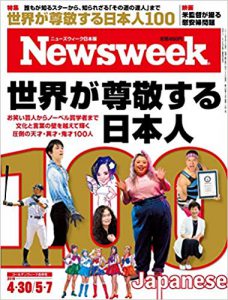
Not only the world-renowned athletes such as Ichiro (former MBL player) and Naomi Osaka (professional tennis player), but also there are many influential Japanese known only in certain countries.
In this feature, I would like to introduce three Japanese whom I am interested in.
Marie Kondo (Tidying consultant)
In 2010, Marie Kondo, “KonMari” became famous in Japan as an author of a bestselling book “The Life-Changing Magic of Tidying Up”. Also, Netflix’s hit show “Tidying Up With Marie Kondo” has been broadcasted since January 2019, and her popularity spread all over the world. In recent years the word “KonMari” has been used in a sense of “tidyng up”. The KonMari Method encourages to keep only those things that spark joy, and to thank them for their service- then let them go. KonMari philosophy has changed the way of thinking about lifestyle, not just how to clean up the space.
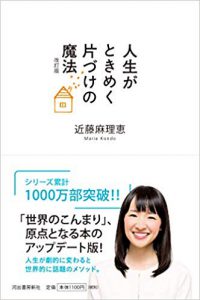
Hirokazu Koreeda (Film director)
I am sure that many of film fans might already know him well. His 2013 film, “Like Father, Like Son (“Soshite chichi ni naru”)”, won the Jury Prize at the 2013 Cannes Film Festival. And in 2018, his film, titled “Shoplifters (“Manbiki kazoku”)” won the the highest prize award “Palme d’Or” at the Cannes Film Festival. Unlike Hollywood style, Mr. Koreeda’s works are not flashy. The themes of his works is usually family matter and relationships, which are very thoughtful. Also, because of the theme, his movies would be very helpful to learn Japanese daily conversations as well.
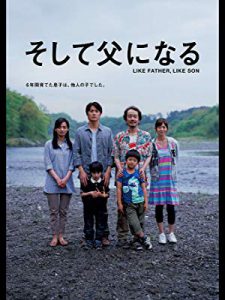
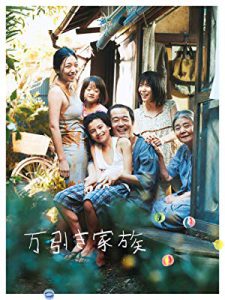
Kazuo Inamori (Entrepreneur)
Mr. Inamori was a founder of Kyocera and KDDI. In 2010, as requested by Japanese government, he took over as chairman of near-bankrupt Japan Airlines (JAL) with no salary. Furthermore, he successfully achieved a V-shaped recovery of 200 billion yen in operating profit in just two years from that, and now is called the god of management. “Seiwajyuku” , the learning groups of Inamori management philosophy, are spread into Brazil, the United States, Taiwan, Korea and Singapore, and his books are sold well in China as well.
As the opposite perspective, I hope someday you might be featured as “100 foreigners the Japanese respect” For that, I will do my best to contribute more for your learning Japanese language. (^ ^) /
Are Automatic Captions on YouTube so accurate?
January 17, 2019

I introduced the live caption and subtitles feature for Skype in the previous article, so this time I would like to share with our readers the Auto Translate Captions on YouTube.
To test the auto translate captions on YouTube, I chose a video that TV Tokyo’s popular news program called “World Business Satellite” introduced our company (Japan Online School).
The following six people (A to F) appear in that video.
A: Japanese / narrator / male
B: Japanese / narrator / female
C: Japanese / Japanese teacher / female
D: Japanese / company manager / male
E: Foreigner / male (Japanese Level = Intermediate)
F: Foreigner / female (Japanese level = advanced)
Here is a compilation video of YouTube’s automatic captioning based on the original speech.
The accuracy rate of automatic captioning in each 6 patterns (A to F) was as follows.
A: Japanese / narrator / male: 81.8%
B: Japanese / narrator / female: 97.3%
C: Japanese / Japanese teacher / female: 88.6%
D: Japanese / company manager / man: 87.3%
E: Foreigner / male (Japanese level = intermediate): 56.6%
F: Foreigner / female (Japanese level = advanced): 85.7%
Concerning the average accuracy rate, native Japanese speakers (A to D) achieved 87.0%, while non-native Japanese speakers (E & F) of 65.2%. As expected, recognition of native speakers’ speech is more accurate than non-native speakers.
Also, the results varied even among foreigners; Ms. F who has almost native level proficiency in Japanese was recognized with high accuracy, while Mr. E with intermediate level was recognized only about half of his speech.
As in the following cases, there were some sentences that became completely wrong meanings from the original.
〇 <Buchoo>, chotto <yoroshii> deshooka.
(Department manager, is it okay?)
× <Moochoo>, chotto <dooji> deshooka.
(Cecum slightly at the same time)
○ Tokyo<Shoji> e dasu kikakusho nandesuga, <me o tooshite> itadakenaideshooka.
(This is a proposal for Tokyo Shoji. Could you please check this for me?)
× Tokyo<Soojigen> e dasu kikakusho nandesuga, <fuufu o twitter> itadakenaideshooka.
(This is a proposal for Tokyo Soojigen. Could you please tweet a couple for me?)
Although the automatic captioning can be affected by background noise and video’s audio quality, the accuracy rate of two foreigners (Mr. F and Ms. E) was almost equivalent to speaking fluency evaluated by a professional Japanese teacher.
Therefore, I can say that those whose speech is correctly recognized by YouTube’s automatic captioning have a considerably advanced level of Japanese.
So please give it a try (^ ^) /
※Accuracy level of automatic captioning on YouTube varies depending on contents of programs.
It recognizes such programs as news and dramas of which texts are mainly based on script more accurate. On the other hand, comedy shows and live interviews are less accurate.
※ This information is as of January 11, 2019.
Categories
Recent Posts
- I cannot keep up with meetings conducted in Japanese. Are there any good ways to study?
- Are there any good writing materials for business Japanese? (Three keys to developing business Japanese writing skills.)
- Are there any free materials available for studying business Japanese reading?
- Should I read newspapers for reading practice in business Japanese?
- Are there any good business magazines to practice reading business Japanese?
Archives
- August 2022
- June 2022
- May 2022
- April 2022
- March 2022
- February 2022
- January 2022
- October 2021
- January 2021
- August 2020
- July 2020
- June 2020
- May 2020
- April 2020
- March 2020
- February 2020
- January 2020
- December 2019
- November 2019
- October 2019
- September 2019
- August 2019
- July 2019
- June 2019
- May 2019
- April 2019
- March 2019
- February 2019
- January 2019
- December 2018
- November 2018
- October 2018
- September 2018
- August 2018
- July 2018
- June 2018
- May 2018
- April 2018
- March 2018
- February 2018
- January 2018
- November 2017
- October 2017
- July 2017
